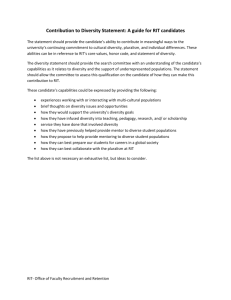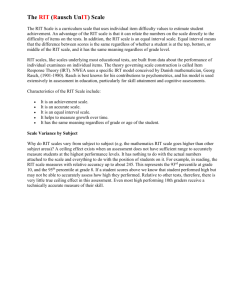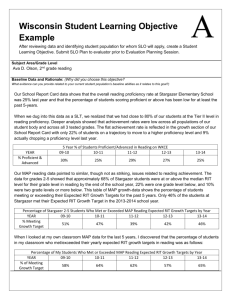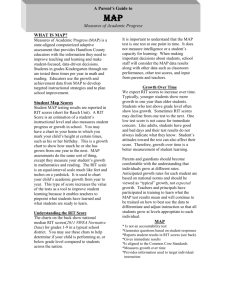Student Learning Objective (SLO) Template SY 2014
advertisement
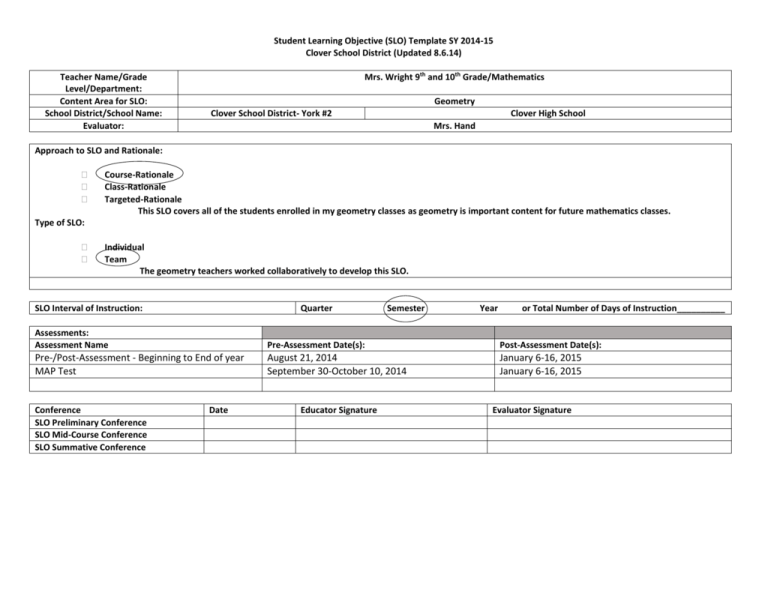
Student Learning Objective (SLO) Template SY 2014-15 Clover School District (Updated 8.6.14) Teacher Name/Grade Level/Department: Content Area for SLO: School District/School Name: Evaluator: Mrs. Wright 9th and 10th Grade/Mathematics Geometry Clover School District- York #2 Clover High School Mrs. Hand Approach to SLO and Rationale: Course-Rationale Class-Rationale Targeted-Rationale This SLO covers all of the students enrolled in my geometry classes as geometry is important content for future mathematics classes. Type of SLO: Individual Team The geometry teachers worked collaboratively to develop this SLO. SLO Interval of Instruction: Quarter Semester Year or Total Number of Days of Instruction__________ Assessments: Assessment Name Pre-Assessment Date(s): Post-Assessment Date(s): Pre-/Post-Assessment - Beginning to End of year MAP Test August 21, 2014 September 30-October 10, 2014 January 6-16, 2015 January 6-16, 2015 Conference SLO Preliminary Conference SLO Mid-Course Conference SLO Summative Conference Date Educator Signature Evaluator Signature I. Objective Statement: (The objective statement should identify specific knowledge and/or skills that are essential for students to attain in the course or grade. The objective statement should be broad enough to capture the major content, but focused enough to be measurable.) Evaluator Comments: By the end of SY 2014-2105, 100% of my students will show measurable growth as defined by at least one of two identified student growth measures. II. Student Population (Characteristics of Target Population): (Provide an in-depth description of the student population. Include any summary pertinent information on the students. Reflect on student strengths, concerns, and how the SLO will be impacted by these. Insert charts and graphs if necessary. Do not include free and reduced lunch information.) Evaluator Comments: 2nd Block: Male Female All Students All W AA Asian Other ADHD IEP 504 ESOL 10 12 22 10 11 21 0 0 0 0 0 0 0 1 1 0 0 0 0 0 0 0 0 0 0 0 0 Free/Red. Meals 0 1 1 Gifted Artistically 0 3 3 Gifted Academically 6 8 14 3rd Block: Male Female All Students All W AA Asian Other ADHD IEP 504 ESOL 8 19 27 6 17 23 2 0 2 0 1 1 0 1 1 0 1 1 0 0 0 0 1 1 0 0 0 Free/Red. Meals 2 1 3 Gifted Artistically 0 1 1 Gifted Academically 7 12 19 I teach a total of 49 students. III. Baseline and Trend Data: (Describe relevant past data for the student population and include cohort data if applicable. Explain how this data helped you identify the learning targets for your students. Insert additional charts and graphs if necessary.) I have no prior knowledge of previous skill level since this is the first year I have taught these students. Therefore, I used TestView to review students’ Spring 2014 MAP RIT Math scores, 2014 PASS Mathematics scores, and their final average of their previous mathematics course. The results displayed the following: Evaluator Comments: 2014 PASS scores SECOND BLOCK 10 students MET expectations 0 students DID NOT MEET expectations 11 students EXCEEDED expectations 1 students had no previous test records on file THIRD BLOCK 5 students MET expectations 1 students DID NOT MEET expectations 21 students EXCEEDED expectations 0 students had no previous test records on file 2014 MAP RIT scores SECOND BLOCK 0 students had a RIT score between 201-210 0 students had a RIT score between 211-220 0 students had a RIT score between 221-230 5 students had a RIT score between 231-240 8 students had a RIT score between 241-250 6 students had a RIT score between 251-260 1 students had a RIT score between 261-270 1 students had a RIT score between 271-280 0 students had a RIT score between 281-290 1 students had no previous test records on file THIRD BLOCK 0 students had a RIT score between 201-210 0 students had a RIT score between 211-220 0 students had a RIT score between 221-230 2 students had a RIT score between 231-240 11 students had a RIT score between 241-250 12 students had a RIT score between 251-260 2 students had a RIT score between 261-270 0 students had a RIT score between 271-280 0 students had a RIT score between 281-290 0 students had no previous test records on file Final Mathematics Average from the Previous Year SECOND BLOCK 8 students completed their previous course with an A average 13 students completed their previous course with an B average 0 students completed their previous course with an C average 0 students completed their previous course with an D average 0 students completed their previous course with an F average 1 students had no previous test records on file THIRD BLOCK 13 students completed their previous course with an A average 14 students completed their previous course with an B average 0 students completed their previous course with an C average 0 students completed their previous course with an D average 0 students completed their previous course with an F average Given the lack of baseline data, I administered a pre-assessment on August 21, 2014. The pre-assessment was a 50 question multiple choice test generated from ExamView. There was a consensus among Clover High School geometry teachers as being a sufficient measure of growth. Evaluator Comments: IV. Assessment Description (Pre and Post): (Describe the assessments (pre/post) that will be used to determine student growth. Include information on how the assessment(s) will be administered and scored. Explain how the educator is ensuring for validity/reliability of the assessment.) Measures of Academic Progress (MAP) MAP is a computer adaptive test that is administered to the whole class in the Fall and Winter. Fall MAP scores will be recorded as a baseline data for this year’s growth targets. Through the NWEA system, students will be given a target RIT score to show one year’s growth in Math. The RIT target will be the Winter MAP target for growth. Pre/Post Test on 100-point scale I will use a Pre/Post Test that is scored on a 100 point scale, which covers essential standards for my course. Growth targets will be set based using the districts 100 point scoring guide which outlines adequate growth from a given pre-test score. Post-test growth projections will be raised or lowered based on prior trends for this course. V. Growth Targets/Rationale: (See data spreadsheet.) Evaluator Comments: VI. Strategies/Progress Monitoring: (Describe the instructional and/or grouping strategies that you will use to teach this content to students. Explain the following: a. How frequently will you progress monitor students mastery of standards taught? b. How and with what instrument will you assess students to measure their progress towards the learning goal? c. What will you do if students do not show adequate progress towards the learning goal? In each lesson, I use a variety of instructional strategies that meet the needs to all students no matter which way they learn best. The strategies present the material verbally, visually, and kinetically. The instructional strategies used during the lessons assist in meeting the expectations and levels of all students, because I pace the lesson so that all students can stay focused. Carnegie Learning is a student-driven curriculum, which easily relates mathematics to real life, allows students to collaborate with their peers, requires students to explain their answers in complete sentences, and thoroughly explains the information on the students’ academic level. Guided note sheets and practice worksheets are sometimes supplemented with the Carnegie Learning curriculum to hold students accountable for understanding. VII. Professional Development (Optional): (Describe any professional development, i.e., graduate courses, workshops, conferences, relating to the SLO that you are participating in or any needed professional development. Explain how participation in the professional development will assist you in achieving student growth.) Evaluator Comments: Calculating Performance Rating Levels Growth Measure Highly Effective 3.5-4.0 The teacher attains a high level of student achievement with all populations of learners. Effective 2.5-3.4 The work of the teacher results in acceptable, measurable progress based on established standards for a significant number of students. Measures of Academic Progress (MAP) 80-100% of students meeting or exceeding their growth target. 50%-79% of students meeting or exceeding their growth target. Needs Improvement 1.5-2.4 The work of the teacher results in student growth but does not meet the established standard and/or is not achieved with all populations taught by the teacher. 20-49% of students meeting or exceeding their growth target. Ex. For a class size of 20 Ex. For a class size of 20 10-15 students meeting or exceeding their growth target. Add all student individual ratings together; Divide by the number of students-The quotient should be 2.5-3.4 4-9 students meeting or exceeding their growth target. Add all student individual ratings together; Divide by the number of students-The quotient should be 1.5-2.4 Ex. For a class size of 20 16-20 students meeting or exceeding their growth target. Other Assessments i.e. Pre/Post Test on 100-point scale; PASS; Fountas and Pinnell; Rubrics Add all student individual ratings together; Divide by the number of students-The quotient should be 3.5-4.0 Unsatisfactory 1.0-1.4 The work of the teacher does not achieve growth. Less than 20% of students meeting or exceeding their growth target. Ex. For a class size of 20 Final Rating: Add individual rating from each growth measure; divide sum by the number of growth measures Example: MAP=4 PASS=3 Fountas and Pinnell=2 4+3+2=9 9/3=3 Final Rating = 3 Effective *Modified from South Carolina Department of Education, Student Learning Objectives Template 3 or fewer students meeting or exceeding their growth target. Add all student individual ratings together; Divide by the number of students-The quotient should be 1.0-1.4



